Archive for July, 2020
» posted on Tuesday, July 7th, 2020 by Linda Lou Burton
Count Me!
 Linda Lou Burton posting from Little Rock, Arkansas – I’m signed up for regular updates from the U S Census Bureau because I love anything that gives me facts and figures to analyze. And as a dedicated student of family history, I rely heavily on Census records to “follow footsteps through time.” I was delighted a few years back when the Census was released that first had MY name on it! I was verified. There is something very satisfying about being counted. And 2020 is time to do it again.
Linda Lou Burton posting from Little Rock, Arkansas – I’m signed up for regular updates from the U S Census Bureau because I love anything that gives me facts and figures to analyze. And as a dedicated student of family history, I rely heavily on Census records to “follow footsteps through time.” I was delighted a few years back when the Census was released that first had MY name on it! I was verified. There is something very satisfying about being counted. And 2020 is time to do it again.
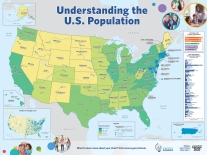 As you may know, every 10 years the United States counts its population. It’s a requirement, written into the Constitution. And the first count dates back to our first president, when U S Marshals conducted the census on horseback. It’s happened once a decade since then, as the country has continued to grow, and changes in our laws, our cultural norms and our attitudes have changed the focus of information gathered, and questions asked, in an effort to make sure everyone is counted.
As you may know, every 10 years the United States counts its population. It’s a requirement, written into the Constitution. And the first count dates back to our first president, when U S Marshals conducted the census on horseback. It’s happened once a decade since then, as the country has continued to grow, and changes in our laws, our cultural norms and our attitudes have changed the focus of information gathered, and questions asked, in an effort to make sure everyone is counted.
1790
The very first U S Census was conducted a year after George Washington took office. Every household in the original 13 states was visited, plus the districts of Kentucky, Maine, Vermont, and the Southwest Territory. The inquiries called for the name of the head of household, and the number of persons living in the household, as described:
- Free white male of 16 years and up (to assess the country’s industrial and military potential)
- Free white males under 16
- Free white females
- Slaves
The count according to that first census as of August 2, 1790 was 3,929,214.
1850
It was 1850 when the inquiries expanded to include every free person’s name, not just the head of household. Relationships were not listed, just names and ages, but additional “social statistics” included information on taxes, schools, crime, wages, and value of the estate.
Zachary Taylor was President of the United States on Census Day June 1, 1850. The U S had grown to 30 states by then, with a population count of 23,191,876.
1870
Census Day was June 1 in 1870 and Ulysses S Grant was President of our 37 United States.
After the Civil War, the decennial census questionnaires were redesigned to end the slave questionnaire. The schedules for the 1870 census were: General Population, Mortality, Agriculture, Products of Industry, and Social Statistics.
This was the first year a rudimentary tallying machine helped with the count, which added up to 38,558,371.
1880
Census Day was June 1 in 1880 and Rutherford B. Hayes was President of our 38 United States.
This census is a genealogists dream, because for the first time, relationships to “head of household” are listed: wife, son, daughter, and such things as lodger, or servant. Information about Alaska was included in this census, as well as all untaxed Indians within the jurisdiction of the United States.
The count in 1880 was 50,189,209.
1920
Census Day was January 1 in 1920 (more people would be at home in January, was the theory, than during the busy summertime) and Woodrow Wilson was President of our 48 states.
The format no longer asked about service in the Union or Confederate army or navy and there was no separate schedule for Indians in 1920. The instructions to enumerators did not require that individuals spell out their names. Enumerators wrote down the information given to them; they were not authorized to request proof of age, and the determination of race was based on the enumerator’s impressions.
Can you guess what our population count was a hundred years ago? 106,021,537!
2020
What will our 24th U S Census reveal?
 The 2020 Census counts every person living in the United States and five U S territories, Puerto Rico, American Samoa, the Commonwealth of the Northern Mariana Islands, Guam, and the U S Virgin Islands. Each home received an invitation to respond to a short questionnaire—online, by phone, or by mail—between March 12-20. No horseback! House calls only as necessary or requested.
The 2020 Census counts every person living in the United States and five U S territories, Puerto Rico, American Samoa, the Commonwealth of the Northern Mariana Islands, Guam, and the U S Virgin Islands. Each home received an invitation to respond to a short questionnaire—online, by phone, or by mail—between March 12-20. No horseback! House calls only as necessary or requested.
Why is it so important to respond?
The census provides critical data that lawmakers, business owners, teachers, and many others use to provide daily services, products, and support for you and your community. Every year, billions of dollars in federal funding go to hospitals, fire departments, schools, roads, and other resources based on census data. The results of the census also determine the number of seats each state will have in the U S House of Representatives, and they are used to draw congressional and state legislative districts.
The Census Bureau will never ask for your:
- Social Security number.
- Money or donations.
- Anything on behalf of a political party.
- Bank or credit card account numbers.
Additionally, there is no citizenship question on the 2020 Census.
If you haven’t responded yet, you can do so online, go here.
https://2020census.gov/en/what-is-2020-census.html
And for a little fun, test your knowledge of census history with this quiz. I did, and (brag, brag) I answered every question correctly. Hint: read the third paragraph of this post and you’ll ace the first question.
https://2020census.gov/en/what-is-2020-census/focus/history-quiz.html
» posted on Monday, July 6th, 2020 by Linda Lou Burton
Birds of a Feather
Linda Lou Burton posting from Little Rock, Arkansas – “Are you a bird watcher? Can you recognize bird calls? There is a particular bird I hear all the time around here that I can’t pinpoint. I’m going to do some research this morning on it.” Those questions were posed to me in my early morning weekly email from friend Rita today.
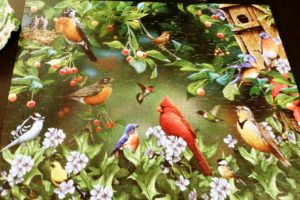 The answer is Yes, and No. My Katy cat and I are inveterate bird watchers, though I suspect for vastly different reasons. (I don’t view them as potential “dinner,” I watch because birds are beautiful, and smart.) My Birds of Arkansas Field Guide by Stan Tekiela is clogged with paperclips as I mark every species of bird I spot in my yard, more than 20 so far.
The answer is Yes, and No. My Katy cat and I are inveterate bird watchers, though I suspect for vastly different reasons. (I don’t view them as potential “dinner,” I watch because birds are beautiful, and smart.) My Birds of Arkansas Field Guide by Stan Tekiela is clogged with paperclips as I mark every species of bird I spot in my yard, more than 20 so far.
Brown-headed Cowbird * Downy Woodpecker * Eastern Bluebird * Blue Jay * Pine Siskin * House Finch * House Sparrow * White-throated Sparrow * Northern Cardinal * Brown Thrasher * Mourning Dove * Red-breasted Nuthatch * White-breasted Nuthatch * Dark-eyed Junco * American Robin * Ruby-throated Hummingbird * House Finch * American Goldfinch * Northern Mockingbird
I can identify these birds because Tekiela’s book includes gorgeous color pictures, as well as detailed descriptions of a bird’s size, and habits. Even their sounds, but there are so many that my answer is “No, Rita I do not recognize bird calls.” I can tell when a call is quarrelsome (and they do get into quarrels around the feeders!). And we all recognize the squawk of a blue jay or the disagreeable sounds that a crow makes, strutting around the yard like the King of Sheba.
 My favorite is the Northern Cardinal, an elegant bird of medium size (8”-9”) with a reddish-orange beak and a black mask. The male is a vivid red, but the female is buff brown with tinges of red on her crest; with the same black mask and orange beak. I’ve noted that the male and female often come to the feeder as a pair; the male first to “check it out;” then he watches as she feeds. He makes a good husband and father – during courtship the male feeds the female; he also feeds the young of the first brood while she builds the second nest.
My favorite is the Northern Cardinal, an elegant bird of medium size (8”-9”) with a reddish-orange beak and a black mask. The male is a vivid red, but the female is buff brown with tinges of red on her crest; with the same black mask and orange beak. I’ve noted that the male and female often come to the feeder as a pair; the male first to “check it out;” then he watches as she feeds. He makes a good husband and father – during courtship the male feeds the female; he also feeds the young of the first brood while she builds the second nest. 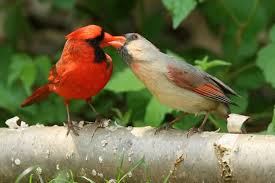 They live in “cup” nests and generally produce 2-3 broods a year, so your yard might have a number of fledglings throughout the summer. Cardinals are non-territorial in the winter time, hanging around Arkansas as non-migrators and gathering in small flocks of up to 20 birds at a time. And their call is, most appropriately Rita, “whata-cheer-cheer-cheer.”
They live in “cup” nests and generally produce 2-3 broods a year, so your yard might have a number of fledglings throughout the summer. Cardinals are non-territorial in the winter time, hanging around Arkansas as non-migrators and gathering in small flocks of up to 20 birds at a time. And their call is, most appropriately Rita, “whata-cheer-cheer-cheer.”
Bird-watching is a great activity to take up anytime, but now with quarantines and social distancing guidelines in place, it goes to the top of the list as an easy, inexpensive, and highly entertaining way to spend time. It is great for young kids, old fogies, and everyone who has a minute, or a long day, stretching ahead. I just sent a hummingbird feeder kit to the mother of a four-year-old tasked with entertaining an energetic little one all summer – in addition to the feeder itself is a pack of wildflower seeds to plant, and tend to, and a book about the hummingbird, one of the hardiest critters God ever created.
 Start your birdwatching with a simple feeder outside a window. You can watch birds coming and going and feeding and chatting from inside your air-conditioned house. If you’re really serious about attracting and caring for birds, create a wildlife habitat in your yard. Birds need a few simple things: cover and places to safely raise their young, and water and food sources. To have your habitat certified by the National Wildlife Federation, you must follow sustainable practices such as reducing lawn size, using native plants, and eliminating chemical pesticides and fertilizers.
Start your birdwatching with a simple feeder outside a window. You can watch birds coming and going and feeding and chatting from inside your air-conditioned house. If you’re really serious about attracting and caring for birds, create a wildlife habitat in your yard. Birds need a few simple things: cover and places to safely raise their young, and water and food sources. To have your habitat certified by the National Wildlife Federation, you must follow sustainable practices such as reducing lawn size, using native plants, and eliminating chemical pesticides and fertilizers.
Besides being a simple bird lover, who finds birds fascinating creatures (yes, they crap on the porch, so what), I am a member of two organizations I recommend to everyone. Yes, they will ask you for money (again, so what).
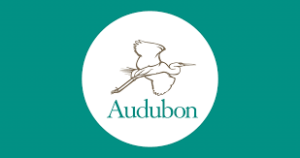 One is the National Audubon Society, whose mission is “to protect birds and the places they need, today and tomorrow. We conserve and restore natural ecosystems, focusing on birds and their habitats, for the benefit of humanity and the earth’s biological diversity.” https://www.audubon.org/
One is the National Audubon Society, whose mission is “to protect birds and the places they need, today and tomorrow. We conserve and restore natural ecosystems, focusing on birds and their habitats, for the benefit of humanity and the earth’s biological diversity.” https://www.audubon.org/
 The other is the National Wildlife Federation, whose statement “We Believe” goes like this: America’s experience with cherished landscapes and wildlife has helped define and shape our national character and identity for generations. Protecting these natural resources is a cause that has long united Americans from all walks of life and political stripes. To hunters, anglers, hikers, birders, wildlife watchers, boaters, climbers, campers, cyclists, gardeners, farmers, forest stewards, and other outdoor enthusiasts, this conservation ethic represents a sacred duty and obligation to protect and build upon our conservation heritage for the sake of wildlife, ourselves, our neighbors, and—most of all—for future generations. https://www.nwf.org/
The other is the National Wildlife Federation, whose statement “We Believe” goes like this: America’s experience with cherished landscapes and wildlife has helped define and shape our national character and identity for generations. Protecting these natural resources is a cause that has long united Americans from all walks of life and political stripes. To hunters, anglers, hikers, birders, wildlife watchers, boaters, climbers, campers, cyclists, gardeners, farmers, forest stewards, and other outdoor enthusiasts, this conservation ethic represents a sacred duty and obligation to protect and build upon our conservation heritage for the sake of wildlife, ourselves, our neighbors, and—most of all—for future generations. https://www.nwf.org/
Check it out. You know the rhyme: birds of a feather, stick together.
» posted on Sunday, July 5th, 2020 by Linda Lou Burton
The Glad Game
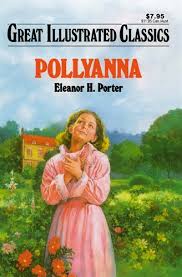 Linda Lou Burton posting from Little Rock, Arkansas – If ever a year called for The Glad Game, 2020 may be it. The Glad Game, you know, a way of coping by looking for the positives in a difficult situation. Eleanor H Porter first wrote about such a “game” in her 1913 novel Pollyanna, a story about a young girl who faced life with an unfailingly positive attitude about everything. Her father created the game when the missionary barrel arrived with a pair of crutches for her, although she’d asked for a doll. “Be glad,” her father said with a smile, “that you don’t need them.”
Linda Lou Burton posting from Little Rock, Arkansas – If ever a year called for The Glad Game, 2020 may be it. The Glad Game, you know, a way of coping by looking for the positives in a difficult situation. Eleanor H Porter first wrote about such a “game” in her 1913 novel Pollyanna, a story about a young girl who faced life with an unfailingly positive attitude about everything. Her father created the game when the missionary barrel arrived with a pair of crutches for her, although she’d asked for a doll. “Be glad,” her father said with a smile, “that you don’t need them.”
After Pollyanna’s mother and father died, at age 12 she was sent to live with a stern aunt who relegated her to a room in the stuffy attic. Still Pollyanna managed to find things to be glad about. Sent to the kitchen with only bread and milk because she was tardy for dinner? “I love bread and milk!” said Pollyanna. She taught The Glad Game to everyone in the village – whiny Mrs Snow, who had been bedridden for years, refusing even to look out the window; grumpy Mr Pendleton, who barely spoke and wouldn’t lift a finger to help a soul. They changed. Even Aunt Polly began to smile as the infectious spirit of optimism filled the house.
That’s the way it works.
I admit to being sad of late. Sad for my three grandchildren who suffered a senior year of school closures and virtual graduation ceremonies, masked and alone even for the filming of those. Sad for my uncle, who spent the last three months of his 96 years in quarantine, a world traveler no more. His body is now stored at the funeral home until August, funerals are that backed up. Sad for my stepmother, also 96, quarantined in a nursing home, no family in-person contact; and for friends experiencing the same situation with their loved ones. Sad for many family members who have been instructed to work from home since March 1, or whose salary was cut, or, who were laid off. Sad that my Round The World trip, which was to begin July 7, will not happen. Sad, by golly, about the toilet paper shortage! And those are just things that affect me directly and personally, before tuning in to the daily news of despair all around the world. It was time to buck up.
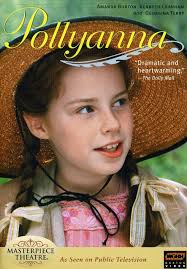 So I called on Pollyanna today. I watched the most recent of the movies that have been made based on Porter’s book, a TV Masterpiece version starring Amanda Burton as Aunt Polly and Georgina Terry as Pollyanna. I am GLAD Eleanor Porter wrote that first book and created the entrancing Pollyanna character. She has cheered folks and lifted spirits through world wars and depressions and other ups and downs for over a hundred years. Other authors have chimed in over time with “Pollyanna Glad Books” – Harriet Smith, Elizabeth Borton, and Virginia Moffit to name a few; I counted fourteen at least.
So I called on Pollyanna today. I watched the most recent of the movies that have been made based on Porter’s book, a TV Masterpiece version starring Amanda Burton as Aunt Polly and Georgina Terry as Pollyanna. I am GLAD Eleanor Porter wrote that first book and created the entrancing Pollyanna character. She has cheered folks and lifted spirits through world wars and depressions and other ups and downs for over a hundred years. Other authors have chimed in over time with “Pollyanna Glad Books” – Harriet Smith, Elizabeth Borton, and Virginia Moffit to name a few; I counted fourteen at least.
A silent film starring Mary Pickford as Pollyanna came out in 1920. Pickford was 23 at the time, playing the role of a twelve-year old! The film grossed $1.1 million ($14 million in today’s dollars), a huge success. You may be more familiar with Disney’s 1960 version starring Hayley Mills, who won a special Oscar for the role.
 Other adaptations of the Pollyanna character include a Turkish musical drama comedy, a BBC TV serial, a Japanese 51-episode anime TV series, a Disney TV musical with an African-American cast, and in 2018, a Brazilian telenovela. Parker Brothers and Milton Bradley produced The Glad Game for a time, and Glad Clubs were in vogue. In 2002 a statue depicting a smiling Pollyanna was unveiled in Littleton, New Hampshire, Eleanor H Porter’s home town.
Other adaptations of the Pollyanna character include a Turkish musical drama comedy, a BBC TV serial, a Japanese 51-episode anime TV series, a Disney TV musical with an African-American cast, and in 2018, a Brazilian telenovela. Parker Brothers and Milton Bradley produced The Glad Game for a time, and Glad Clubs were in vogue. In 2002 a statue depicting a smiling Pollyanna was unveiled in Littleton, New Hampshire, Eleanor H Porter’s home town.
Hang Miss Pollyanna’s picture beside your TV screen, or wherever you get your daily pandemic updates. A little optimism can go a long way. It radiates, you know.
